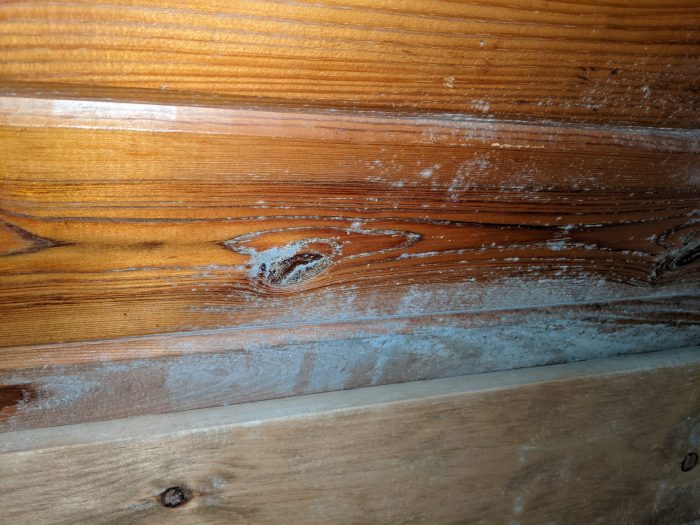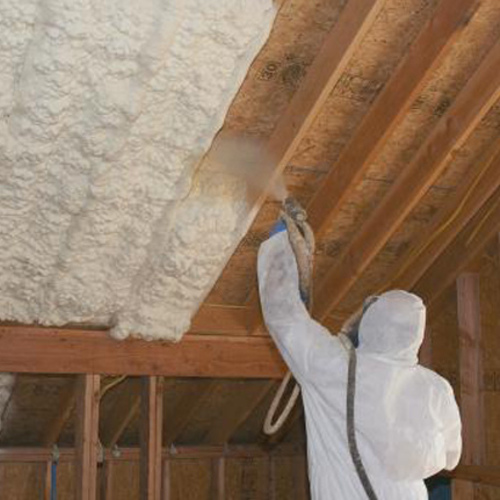
Cavallaro, a GBA reader from Arkansas, replaced a wood shingle roof on his 1975 A-frame house last year with standing-seam metal, but far from enjoying the upgrade Cavallaro is ready to tear off the new roof and start again.
The problem? Mold.
“The new vapor-impermeable roof caused moisture to build up inside,” he reports in this recent Q&A post. “In addition, the metal changed the temperature of the interior roofline causing condensation build up and mold to grow all along the interior roof during winter.”
The roof consists of 2-in.-thick tongue-and-groove boards—no attic, no air gap, and apparently no insulation. Just wood. Mold is one issue, odor is another. In the heat of summer, Cavallaro says, the metal roofing heats up the underlayment and makes a “horrendous” smell inside the house. All of it, he says, has been an emotional challenge.

Cavallaro has concluded that the metal roofing has to come off. He’d add 3 in. of polyiso insulation, OSB sheathing, a self-adhering waterproofing membrane, underlayment, and then, finally, reinstall the metal roofing.
“Is this the correct solution in addition to reducing interior moisture?” he asks. “Is an air gap necessary directly below the metal roof for efficiency gains? Will we smell the second layer of underlayment in the summer? How much more efficient is a light-colored roof than a darker (charcoal gray) roof?”
Those questions are where we start this Q&A Spotlight.
A roof guaranteed to fail
As built, writes Akos, the roof was bound to fail. The layer of Ice & Water Shield installed over the T&G roof is vapor impermeable, so winter condensation and mold should come as no surprise.
“The solution with exterior rigid insulation you are looking at…
Weekly Newsletter
Get building science and energy efficiency advice, plus special offers, in your inbox.

This article is only available to GBA Prime Members
Sign up for a free trial and get instant access to this article as well as GBA’s complete library of premium articles and construction details.
Start Free TrialAlready a member? Log in















6 Comments
I am no building expert so I will not comment on the insulation issue. However, it seems from the pictures that you have quite a bit of vegetation right next to your foundation/crawlspace that may be retaining a lot of moisture. Also, the A frame roof line is so steep it seems to direct a lot of rainwater right next to your foundation and I wonder if the water flows right over yor gutters because of the velocity flowing down the slick metal roof. I suspect you would need very wide gutters and leaders on the ground that effectively divert most of the rainwater far from the house. Given how steep the roof is, I wonder if on windy days rain just bounces off the metal roof and settles right next to the foundation?? And the valley between the two A frames deposits right on your deck so I imagine there is a lot of water deposited on or under the deck when the rain comes from this side.
Again, maybe this is just the way the pictures look, but if not I would consider these issues as well as dealing with the insulation. When my house had moisture problems in the basement, I removed vegetation close to the foundation, attached downspoutso water moved away from the foundation and in one area installed some plastic tarps sloped away from the house buried just below ground cover so bulk rainwater moved away from the house...These were cheap solutions that reduced water intrusion into my foundation significantly. That can't hurt the overall mositure problem in the rest of the house.
You can look at the Quik-Therm Matrix roof system, which combines EPS foam, vapour open films and integrated wood strapping in two layers to remove thermal bridging from the screws.
https://quiktherm.com/product/matrix/
First, a simple suggestion: If you want a low-cost way to get to whatever R-value target you choose, or a way to get a higher R-value from your budget, EPS or GPS is going to be cheaper than polyiso.
If you are looking for code justification for less than R-38, I note that this is steep enough that you might be able to call it a set of walls.
In fact, that's how it was working before, as a wall, vapor open without a completely waterproof layer. It's possible consider going back to something like that, which then could allow the use of different, cheaper insulation, although by the time you are done with setting up for that it's probably cheaper to use EPS or GPS.
Kohta, that graph of dew point vs. height is very interesting! Is there a report that this is in or is this its first publication? Is there work on developing a model that can predict that? It seems like one less from that is that the practice of taking exhaust for HRV/ERV from high up is good practice, and perhaps we should put return ducts for whole-house dehumidifiers there too.
"Kohta, that graph of dew point vs. height is very interesting! Is there a report that this is in or is this its first publication?"
The graph there is from a client report, but Joe Lstiburek wrote about this phenomenon here--scroll down towards the end.
BSI-006: No Good Deed Shall Go Unpunished
https://buildingscience.com/documents/building-science-insights-newsletters/bsi-006-no-good-deed-shall-go-unpunished
Would it be wrong-headed to think of a dehumidifier as capturing the latent heat from the (unwanted) moisture and depositing that heat indoors where it is needed-- Instead of venting it?
Of course, there may be other reasons to just vent instead, such as other air quality issues.
Perhaps the answer to this depends on the efficiency of the heating system the dehumidifier heat would be replacing? And I suppose it would depend on the efficiency of the heat recovery (if any) of venting.
Tyler,
The answers to your questions are yes, it's smart to think of it that way, yes, there are other reasons to vent, and yes, which approach uses less energy depends on the heat system and dehumidifier efficiencies, as well as the indoor and outdoor temperatures and humidities, and the HRV characteriestics. I've run numbers and found that the dehumidifier can be attractive when you want some heat, and when the outside is high humidity and only a mild temperature.
Log in or become a member to post a comment.
Sign up Log in